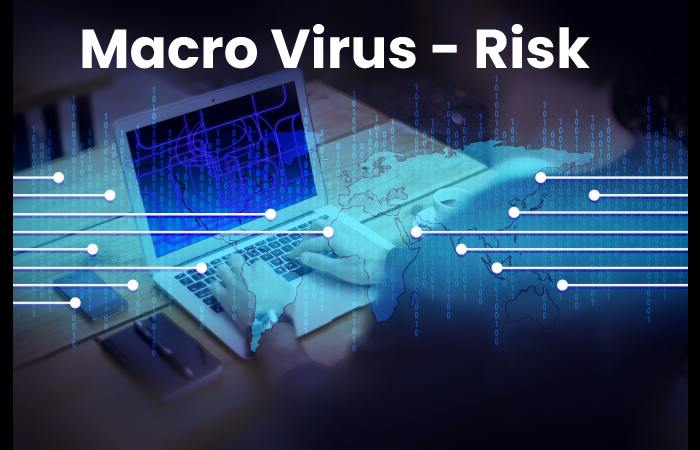A macro virus is a computer virus that modifies or replaces a macro. It is, in turn, a set of commands that programs use to perform everyday actions. For example, the “Open Document” action in many word processing programs is based on a macro, as the process consists of several steps. Macro viruses replace this set of commands and activate each time the macro executes.
Table of Contents
What do Macro Viruses do
When a macro virus runs on your computer, it can execute its payload, the portion of the code that performs the attack. Because macro viruses are written in the same macro language you are using, they can affect applications and files.
Macro Viruses Can:
- Infect other files.
- Make unwanted changes to files, such as deleting or changing content and adding images
- Create new files.
- Corrupted files and other data
- Sending files and emails to other people (thereby spreading from one victim to another).
- Reformat the hard disk.
- Infect your computer with other malware.
Signs that your Device might be Infect with a Macro Virus
Macro viruses can slow down your computer, modify or modify files, and change how your computer behaves. The following symptoms may indicate that you have a macro virus on your computer.
- The computer is suddenly running slower than usual. It may be because the virus copies itself over and over.
- Files are password protected when they didn’t exist before and you haven’t set up password protection.
- Detect unexplained changes to files.
- Some files are missing.
- Your contacts inform you that they are receiving strange emails from you.
- The menu options in the program you are using have changed.
- You start seeing strange error messages when you open or use specific files.
- Any of these symptoms could indicate the occurrence of malware. AVG Antivirus Free monitors your computer in actual time to spot and remove macro viruses and other malware. Use advanced threat detection technology to stop malware infections before they happen.
Macro Virus – Risk

The main risk of macro viruses is their ability to spread rapidly. When an infected macro execute, all other documents on the user’s computer become infected. Some viruses cause inconsistencies in text documents, such as missing words or new words. In contrast, others contact email accounts and send copies of infected files to all of the user’s contacts, who will open and access them because they come from a reliable source.
These viruses can also design to delete or compromise stored data. Also, it is essential to note that macro viruses spread across all platforms; That is, they can infect computers with Windows and Mac operating systems through the same code. Therefore, any program that uses macros can act as a host, and any copy of an infected program that is sent via email or saved to a hard drive or USB drive will contain a virus.
To remove such viruses, users must use security software that provides specific functions for macro virus detection and removal tools. In addition, regular scans recommend for cleaning up potentially infected documents and ensuring no new computer viruses have been re-downloaded.
Which Programs are Most Affected by Macro Viruses?
Because macro viruses target specific software, the victims are often widely used programs, such as Microsoft Office. The problematic is so common that Microsoft has taken many precautions against these viruses. Macros disable by default in your apps, and you’ll see warnings whenever you enable them.
It means that cyber criminals use social engineering gimmicks to spread their junk. They’ll send you infected files from trusted contacts, as you’re more likely to open the file from your “mom” or “friend” than a stranger. Once you have the file, you may not think twice about running the macros regardless of what they sent you. In other words, hackers use our friends and innate curiosity, not software vulnerabilities, to spread macro viruses.
And once infected, the macro virus can spread through your contact list, repeating the cycle.
Several macro viruses specifically affect Microsoft Word. And although Microsoft programs are the most victims, these viruses aren’t limited to Windows computers: Macs can also be infected with macro viruses, as they can run Word, Excel, and other Office applications.
Macro Virus Symptoms
The most obvious sign of a macro virus is a popup asking you to enable macros. So consider what you’ve done recently to determine if you have an infection. Once infected, the symptoms can be similar to those of other computer viruses. Oh! That is the matter:
- Device performance prolong
- Weird error messages appear.
- Those files when you don’t usually ask for a password
- Your device saves documents as templates
- All these symptoms affect the computer’s performance and increase the chances of infecting other devices.
- Connect antivirus software to scan your device for macro viruses (or any other computer virus).
- Avast Free Antivirus automatically detects and removes viruses from your device and blocks all types of malware before they affect you.
How to Avoid Macro Virus?

Since macro viruses have become so mutual, Microsoft Office now disables macros by default. However, if you open a folder with macros, you’ll see a popup asking permission to enable them. Think carefully before doing this; never allow macros on files from unknown sources.
Here are Other Ways to Prevent a Macro Virus from Infecting your Computer:
If you are not expecting to receive attachments, then never open them. Macro viruses can trick people you know into sending you emails, so just opening attachments from people you trust isn’t enough.
Don’t click on links in suspicious communications, even if they come from people you know. These could be phishing messages activated by a macro virus.
Use an email service with a good junk filter. Spam filtering will prevent you from receiving too many phishing emails.
Do not enable macros. Macros can be helpful, but they disable by default. Use it only with files you create or trust.
Again, don’t enable macros until you’re sure a file is safe.
Constantly update your software. Software updates often include security patches to prevent malware from taking advantage of known vulnerabilities.
Use a reliable antivirus tool. If you use one of the best free antivirus software program solutions, you will be infected with macro viruses and other types of malware before they infect your computer.
Also Read: Conclusion
One of the most hazardous types of viruses, but still largely unnoticed by all users who carry out their activities within the scope for which it was created, is the so-called macro virus, a malicious program design to run. Programs, called macros, are found in office suites such as Office, public offices, businesses, and personal computers worldwide.
If you want to study more about the dangers of macro viruses, feel free to carefully read the entire content of this post, where you will find everything you need to avoid problems with this type of virus, which is very common in offices.
Helpfull resourses;
Document Management – Introduction, Work, Process, and More
Cloud Migration – Introduction, Strategies, Benefits, and More
Digital Transformation – Introduction, Benefits, Objectives, and More
Related posts
Featured Posts
Protecting Your Assets: Understanding Oklahoma Bankruptcy Exemptions
In the realm of financial distress, bankruptcy can be a daunting yet necessary solution for individuals seeking relief from overwhelming…
Wall Décor – 27 Wall Décor Ideas to Update your Space
Wall Décor Ideas to Update your Space Wall Décor – Are you looking for wall décor ideas to revamp your…

